We fight tomato diseases easily and effectively: a selection of the best recipes for treating diseases
Tomatoes, like other crops, suffer from diseases, therefore, they need agrotechnical protection, from planting seeds to harvesting. If you do not take action and do not heal the plants, diseases can reduce the yield and even destroy the bushes.
Those who grow tomatoes need to know the main symptoms of diseases in order to choose the right control methods and preventive measures.
The content of the article
What are the diseases of tomatoes
Diseases of tomatoes are conventionally divided into three groups:
- Fungal diseases - powdery mildew, gray rot, late blight, cladosporosis, alternaria, anthracnose, fusarium, root rot, sclerotiniasis, didimella fungus.
- Bacterial - black spot, tomato cancer.
- Viral diseases - aspermia, stem necrosis, mosaic.
How do diseases manifest
Viral diseases cannot be treated; they can only be prevented. Unfortunately, there is one comprehensive method of struggle against viral diseases - to burn diseased plants and prevent vectors (aphids, whiteflies, thrips, etc.) from spreading. Therefore, it is extremely important to timely identify the disease in the early stages.
Viral diseases:
- Mosaic. The causative agent of the mosaic is the Tomato mosaic tobamovirus (ToMV) virus. Symptoms of the disease are spots on the leaves of tomatoes in the form of dark and light green mosaics, defective fruits.
- Stem necrosis... The causative agent of tomato stem necrosis is a virus - Pseudomonas corrugata Roberts and Scarlett. Symptoms are spots on the stems that are elongated and slightly depressed, brown-brown in color, located not high above the substrate, which turn into cracks.
- Aspermia... The causative agent of aspermia is the virus - Tomato aspermy cucumovirus - AsTV (Cucumovirus). The main symptoms are: excessive bushiness, poor development of axillary and lateral shoots, deformation of leaves and stepchildren, mosaic coloring, the edges of the leaves are pink or bluish, flowers are fused, seeds are underdeveloped or absent.
Bacterial diseases:
- Black spot... The causative agent is the bacterium Xanthomonas vesicatoria (ex. Doidge) Vauterin et. al. Symptoms are watery dotted spots up to 1-2 mm in size, gradually turning yellow at the edges. On green fruits, the lesion appears as a scab or raised black dots surrounded by a watery border. Over time, the spots increase to 6-8 mm, take the form of ulcers, the border is replaced by a greenish zone. The tissue under the ulcers decays.
- Tomato cancer. The causative agent is the bacterium Clavibacter michiganensis subsp. michiganensis (Smith) Davis et al. The first symptoms of bacterial cancer are unilateral wilting of leaf lobules, which turn yellow along the edge and slightly curl upward. Plants begin to wither, as a rule, from the bottom. Tomato bacterial cancer is also called "bird's eye", as spots turn yellow on red fruits and black cracks form in their center.
More about tomato bacteriosis:
Fungal diseases:
- Powdery mildew. The causative agent of the disease is the fungus Oidium erysiphoides Fr. Symptoms - yellow spots, first on the upper side of the leaves, and then on the lower and upper sides - a powdery coating.
- Late blight... The causative agent is Phytophthora infestans Mont.de Bary - belongs to the genus of mushroom-like protozoa from the department of oomycetes, that is, not quite a mushroom and not quite the simplest. When the plant is damaged, necroses of various shapes are formed on the fruits and leaves, brownish-brown in color with a light border, vague.
- Cladosporosis... The causative agent of the disease is the fungus Cladosporium fulvum (Cooke.) Cifferri. Rounded yellowish-brown spots appear on the upper side of the leaves, which then turn reddish-brown in color.
- Alternaria (dry spot) is caused by fungi of the genus Alternaria. The main symptom is the appearance of dry, well-defined rounded spots (ranging in size from a few millimeters to several centimeters) of a gray-brown color.
- Anthracnose leaves tomato is caused by the fungus Colletotrichum atramentarium. The disease manifests itself in the form of brown spots, with a diameter of 2 to 12 mm, with a dry, often cracked to holes, pith and a clearly visible border around the edges.
- Fruit anthracnose tomato. The disease is caused by infection by the fungus Colletotrichum phomoides. On ripening fruits, dark, depressed, often zonal spots appear, up to 1 cm in diameter.
- Fusarium. Plant disease caused by the fungus Fusarium oxysporum f.sp lycopersici. Signs of fusarium are leaf chlorosis. It starts from the lower tiers and spreads upward, covering all leaves.
So, there are many diseases of tomatoes, the symptoms are similar, and sometimes it is difficult to determine which pathology has affected the plant.
Attention!It is possible to establish the disease with absolute precision only in a microbiological laboratory.
Not all spots on the leaves indicate a dangerous disease and lead to loss of yield and death of bushes. How to decide which manifestations on the leaves are very dangerous, which are less dangerous, and which are insignificant?
As a rule, spots are manifestations of certain fungal diseases, since the conditions in nature are non-sterile and fungi or bacteria are always present either in the soil, or in the greenhouse, or on plants.
A bad sign is the presence of spots on the upper leaves of the bush, as well as on the petioles, stems and fruits. It is bad when the spots burn through the leaves. Mold on the leaves is also bad. If you saw such spots - take urgent measures!
If spots appear on the upper side of the lower leaves of tomatoes, but there are no spots on the underside of the leaf, there is no leaf burning through and there is no hairy speck, then it is unlikely that such spots will damage the crop. Often the edge of the sheet is as if burnt - like an edge burn. This can be from the sun, dew and poor absorption of potassium in the soil. It is unlikely that such spots will affect the crop.
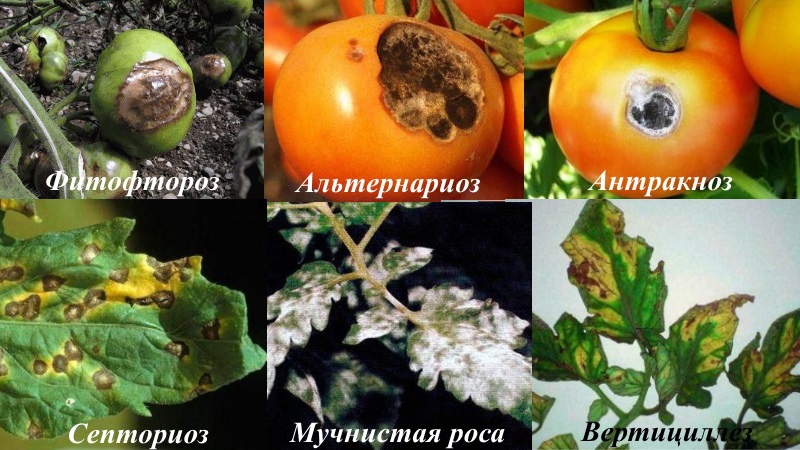
Conditions favorable for the development of diseases
An abundance of moisture and a lack of heat, sudden changes in temperature - these are the conditions favorable for the development of diseases.
The most dangerous months for the development of diseases are July and August, since the temperature drops at night and rises significantly during the day, which entails the appearance of dew.
High humidity can occur due to dense planting of bushes. The moisture does not have time to completely evaporate, therefore it settles on the stems or leaves.
The abundance of nitrogen in the soil and the lack of trace elements also contribute to the development of diseases. So that plants are not affected by diseases, it is necessary to monitor a sufficient amount of iodine, copper, potassium and manganese in the soil.
Tomatoes planted too close to potatoes are more likely to be at risk of late blight.
Important! Moisture and lack of sun are the main conditions for the development of phytophthora.
Rules and terms for processing tomatoes
Processing is carried out in clear and calm weather, early in the morning or in the evening. Foliar treatments should be carried out by carefully spraying the outer and inner sides of the leaf with a fine spray.
To protect the crop from diseases, preventive treatments will be needed, at least four per season.
The first tillage is carried out even before the tomatoes are planted.Subsequent treatments are carried out every two to three weeks until harvest.
Folk remedies for disease control
Now many gardeners avoid using chemicals on their plots and resort to very dubious methods, for example, such as:
- spraying with a solution of table salt against late blight;
- processing tomatoes with soda;
- furacilin;
- streptocide;
- a solution of soda in milk whey;
- potassium permanganate;
- vinegar;
- iodine;
- brilliant green;
- calcium chloride;
- boiling water;
- ash;
- metronidazole or trichopolum;
- screwing in copper wire, etc.
Spraying with a solution of sodium chloride and soda is considered harmful advice, since plants do not like sodium. Earlier, in the era of scarcity, in greenhouse farms, a composition of soda ash and milk whey was used against diseases, where soda served as a neutralizer of excessive acidity.
When fighting powdery mildew, whey is really effective, as it forms the thinnest film on the surface of the leaf, which prevents the penetration of the pathogen. However, the pathogen of phytophthora is "not afraid" of whey and develops well on it.
Milk whey in combination with ammonia is an excellent means for plant nutrition and at the same time a medicine against powdery mildew.
Means such as: iodine, brilliant green, vinegar are radical. The fact is that effective concentrations of these substances are detrimental not only to phytophthora, but also to plants.
An ancient and funny method of fighting late blight, which was used by our grandparents, is to pierce tomato stems with copper wire. Its essence is that late blight is "afraid" of copper compounds. To "scare" the phytophthora, they used copper wire, smoothed with sandpaper and cut into 3-4 cm pieces. The stem of each plant in the lower part was pierced through with wire, its ends bent down.
When treated with such remedies, you can waste time and lose plants and crops.
Of the effective folk-scientific methods of combating late blight, I would like to recommend one of the recipes of the Belarusian scientist Ivan Russian. For plant protection, he used a solution with the addition of turmeric.
Indeed, turmeric is an amazing natural antibiotic. To use it to protect tomatoes, you need to make an alcoholic extract: 20 g of turmeric powder per 0.5 l of vodka. For processing plants, a mixture of 2 tablespoons of an alcoholic extract of turmeric is prepared (without stirring up so that the particles of turmeric do not clog the spray), 2 g of boric acid (dissolve in warm water), 1 tablespoon of ammonia from a pharmacy, 0.5 liters of milk (for better stuck to the leaves). The resulting mixture is dissolved in 10 l of water and sprayed on the plants.
In the fight against fungal diseases, a 1% solution of pharmacy glycerin (100 g per 10 liters of water) helps well. Glycerin is a natural compound that is safe for plants. When sprinkled with glycerin, an increased osmotic pressure is created in the leaves, which weakens the fungal hyphae and inhibits their development.
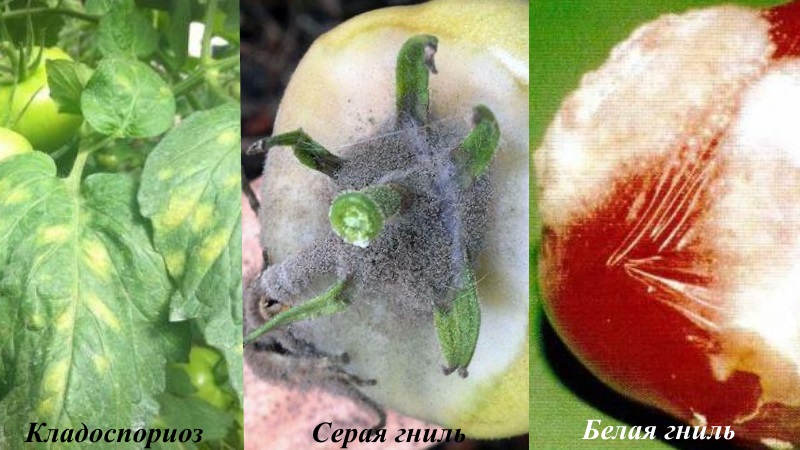
Fighting with chemicals
If the situation with diseases in your garden is neglected, it is worth trying chemical methods of struggle.
Chemical, or inorganic, fungicides are composed of various chemical compounds that have a pronounced effect. Fungicides that are used for tomatoes are divided into:
- copper-containing (copper vitriol, "Bordeaux mixture", "Hom," Oksikhom "," Medyan extra ");
- sulfur-containing (sulfuric checker);
- strobilurins ("Profit Gold");
- carboxins (Previkur Energy).
Important! Fungicides are contact and systemic. "Contact" form a surface film on plants and actively affect the fungal infection only through direct contact. "Systemic" fungicides, after hitting the surface, penetrate into all plant tissues and destroy the pathogenic fungus in any part of it.
It is necessary to work with chemicals in rubber gloves and goggles. Protect the respiratory tract with a respirator or cotton-gauze bandage.
Copper preparations
Widely known and widespread in the fight against various diseases of tomatoes are copper-containing preparations.
Copper-containing preparations are divided into derivatives of copper sulfate (Bordeaux and Burgundy mixtures) and copper oxychloride ("Oxyhom" and "Hom").
Copper sulfate possesses fungicidal and bactericidal action and is effective against a wide range of fungal and bacterial diseases of various crops.
Attention! Copper sulfate should be handled with care due to its high toxicity to humans and the environment.
An aqueous solution of copper sulfate of any concentration is characterized by an acidic reaction, and therefore has phytotoxicity, that is, it can cause leaf burns and damage to fruits. Therefore, a solution of copper sulfate in its pure form is not used during the growing season.
Bordeaux liquid is often used to combat plant diseases.- a mixture of copper sulfate with quicklime. Lime is added to neutralize the excess acidity of the copper sulfate solution. You can buy Bordeaux mixture at the store.
Burgundy mix - consists of solutions of copper sulfate and soda. It is a less durable substitute for Bordeaux mixture. The advantage is that a film does not form on the leaves, impairing photosynthesis.
Copper oxychloride derivatives - "Hom" and "Oxyhom". Despite the fact that both drugs contain copper, their mechanism of action is different. Due to chlorine, “Hom” penetrates into plant tissues, and “Oxychom” (copper oxychloride with oxadixyl) envelops the surface of the plant and prevents infection from penetrating deep into the tissues. Oxadixil has a prolonged effect, it penetrates into the structure of plant tissues and inhibits protein synthesis of pathogenic microorganisms. Therefore, at the initial stage or for prophylaxis, it is better to use "Oxyhom", and "Hom" - when the disease is started.
The drug "Ordan" is a complex drug with a systemic contact effect. Due to the combination of copper oxychloride with cymoxanil, it performs several tasks at once: copper oxychloride has a fungicidal and bactericidal effect, and cymoxanil heals the plant and also protects it from re-infection.
"Kartocid compound" - This is also a copper-containing preparation, a contact-systemic fungicide. Effective in the fight against downy mildew, rust, many types of leaf spot, gray mold, scab, drying out, anthracnose. Kartocid enters the plant through the foliage and acts on fungal and bacterial pathogens "from the inside": it stops their development, leads to the death of pathogens.

Sulfur preparations
Sulfur preparations are contact fungicides with protective and curative effects. Sulfur-based preparations have been used for a long time, but the mechanism of their effect on pathogens is still not clearly understood.
Greenhouses are fumigated with sulfur before planting plants in the spring to eliminate foci of fungal infections on the walls.
Strobilurins
The class of fungicides "strobilurins" has a systemic, immunostimulating effect. They are used against powdery mildew, rot, rust, scab, peronosporosis, late blight, mildew, and other spots. Almost all phytopathogens of fungal origin fall into the zone of action of this group of drugs.
Strobilurins destroy mushrooms of 4 classes: oomycetes, ascomycetes, basidiomycetes and deuteromycetes. They are able to move beyond the point of plant growth, providing protection for young growing organs. They are resistant to temperature extremes, quickly penetrate into the plant, providing long-term protection. Ideal for prevention.
For tomatoes it is recommended to use "Profit Gold"... Its two active ingredients, cymoxanil and famoxadone, provide effective treatment against various fungal infections. Cymoxanil penetrates the plant and acts on the fungus from the inside, blocking its development. And the second component kills the fungus and its spores, and also forms a thin film on plants.
Carboxins
For example, "Previkur Energy" is a systemic two-component fungicide used for watering and spraying fruit and berry crops, garden and indoor plants. The active ingredient of the preparation: 530 g / l propamocarb and 310 g / l fosethyl in the form of propamocarbphosethylate. The drug is highly specific, works against root and root rot, peronosporosis (downy mildew), late blight.
"Previkur Energy" is quickly absorbed by the plant and begins to heal at least 30 minutes, maximum one day after treatment. Therefore, it is not scary that it will be washed off by rain, and there is no need to add "adhesives".
It is also good because its waiting period is only 24 hours, while for other chemicals this period is 5 days.
Unfortunately, some tomato or potato varieties are sensitive to Previkur Energy - you can burn the leaves and lose your crop! Therefore, before you start spraying, test the drug on one bush, wait 1-2 days, and only if no spots (light, yellowish) appear, process all bushes or seedlings.
Attention! The effect of the use of chemical fungicides is obvious and long-term, but these drugs can cause damage to both plants and animals. They also permanently pollute the soil.
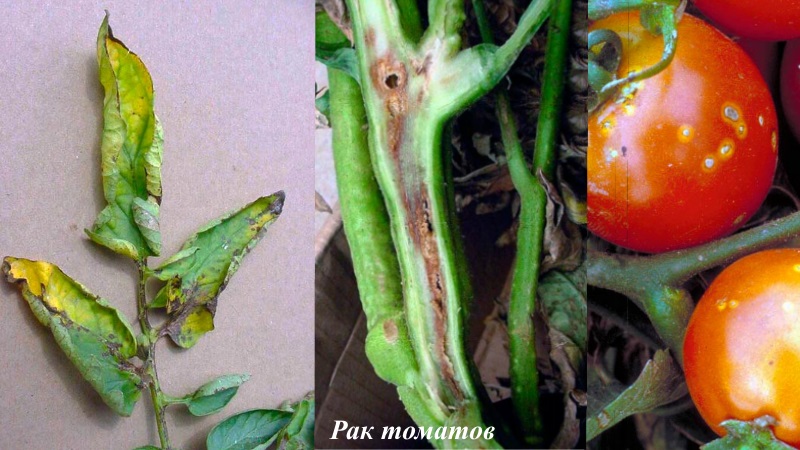
Biological control methods
Biological methods for controlling plant diseases are designed to minimize crop damage. The biological method is based on the destruction or suppression of the development of pathogens with the help of other living organisms or products of their vital activity.
It has been established that root rot of various crops caused by Fusarium, Helminthosporium, Rhizoctonia and other fungi are well treated with antagonist soil fungi such as Trichoderma sp.
The phenomenon of antagonism in nature is called antibiosis, and substances secreted by microbes are called antibiotics. Most of the antagonist microbes are isolated from the soil microflora. For artificial reproduction and use of antagonist microbes, solid and liquid nutrient media are used. The resulting pure culture of the antagonist is dried, ground, and kaolin or other excipient is added. For example, the preparation "Trichodermin" is prepared, which is a pure culture of the soil fungus Trichoderma lignorum.
Other preparations with Trichoderma sp active ingredient: "Glyocladin", "Trichocin", "Sporobacterin". All biological products are of a broad spectrum of action. They effectively fight against late blight, oversporosis, fusarium, powdery mildew and various rot.
In addition to biological products based on Trichoderma sp., There are preparations of the spore bacterium Bacillus subtilis or hay bacillus. Hay stick spreads more slowly than Trichoderma sp., But penetrating into the plant, destroys various diseases from the inside. The waste products of this bacterium inhibit the development of many plant diseases. The bacterium is able to spread through the vessels of plants and cleanse them from diseases.
Hay stick is the basis of such biological products as: "Fitosporin", "Baktofit", "Phytocid", "Fitodoctor", "Alirin B", "Gamair", "Sporobacterin" and others.
How to spray with Gamair
Spraying, watering plants with biological products is carried out in any weather, but it must be taken into account that the bacteria of the hay bacillus Bacillus subtilis and the fungus Trichoderma sp. Are afraid of the bright sun, and the rain can wash off part of the drug. Therefore, it is advisable to process immediately after rain or 2-3 hours before it, in the evening or morning sun. The number of sprays for medicinal purposes depends on the weather conditions - one spraying every 14 days in dry weather and every 7 days during the rainy season.
Garden crops and indoor crops should be watered at the root with the drug once, and fruit and berry crops twice a month.
Treatment of soil and plants with biological products is an excellent prevention of fungal diseases - late blight, fusarium, powdery mildew, scab, phomosis, black leg, etc. They heal and vitaminize the soil.
Measures applicable outdoors
Many gardeners wonder why plants in the wild don't get sick. In fact, why? The fact is that a person, conducting any cultural events, changes the natural living conditions of plants.
When caring for crops, gardeners and gardeners use mineral fertilizers, pesticides, herbicides, which are always poisonous. For example, where a large amount of nitrogen is used, the soil intensively loses humus. Naturally, plants grow faster, more luxuriant, become dark green, but inside the leaves they form a loose spongy tissue
It is quite obvious that "loose" plants that have undergone uneven growth shifts are more susceptible to fungal diseases. It is known that the lower the humus content in the soil falls, the more susceptible plants become to fungal diseases and insect attacks.
It is easier to carry out disinfection measures in a greenhouse. And in the open ground, it is almost impossible to completely destroy sources of infection, but you can improve the soil.
 For starters, try not to use chemicals. Give preference to biologics. Enrich and heal the soil by sowing green manure plants. Plant crops subject to fungal infections after onions, garlic, cabbage, legumes. Tomatoes should not be planted after nightshades (peppers, eggplant, potatoes). For planting, use healthy material - only disinfected seeds.
For starters, try not to use chemicals. Give preference to biologics. Enrich and heal the soil by sowing green manure plants. Plant crops subject to fungal infections after onions, garlic, cabbage, legumes. Tomatoes should not be planted after nightshades (peppers, eggplant, potatoes). For planting, use healthy material - only disinfected seeds.
After harvesting 2-3 weeks before the onset of autumn frosts, spill the soil with solutions of biological products "Baikal EM-1", "Baikal EM-5", "Baktofit", "Trichodermin", "Planzir", "Alirin B", "Fitosporin" or "Phytocide M". Microorganisms suppress the development of phytopathogens, heal the soil. In the spring, after the onset of stable warm weather, repeat the tillage.
How to use biological products, see this video:
New biological preparations for restoring soil fertility - "Flora-S" and "Fitop-Flora-S" have appeared on the market. FLORA-S is pure humic acids obtained from natural raw materials, peat.
For reference. Manufacturers of the preparations assure that by using the "FLORA-S" and "FITOP-FLORA-S" preparations in a complex it is possible to "quickly and effectively restore natural fertility, achieve the unity of biochemical and microbiological processes in soil and plants."
Thus, only complex measures will help to thoroughly disinfect the soil at the site and prevent the development of fungal infections. Follow these guidelines annually and your garden crops will yield a rich harvest of healthy fruit.
If the disease appears in the greenhouse
The stagnant air of greenhouses, evaporation of moisture from the soil makes the growth of tomatoes in greenhouses extreme. In greenhouse conditions, diseases spread more intensively than in open ground.
Therefore, even before the appearance of signs of the disease, be sure to carry out preventive treatments of plants with biological preparations.
If the disease nevertheless appeared in the greenhouse, immediately remove the diseased leaves and burn them. Ventilate the greenhouse, reduce watering and carefully treat the plants, preferably with biological agents.
Prevention methods
To prevent the development of diseases, inspect the plants more often and carry out agrotechnical measures in a timely manner (feeding, pinching, removing diseased leaves, etc.), water with warm water at the root in time, without touching the leaves.
How is prevention carried out in a greenhouse
It is important to prepare the greenhouse in the fall - to remove the tops of the plants that were grown in the greenhouse. As a last resort, do it in the spring. Polycarbonate or glass in the greenhouse must be washed from settled dust, dirt and spores of pathogenic fungi and bacteria. A clean greenhouse is the key to a good harvest!
It is advisable to lay a layer of hay 20-25 cm on the ridges and spill it thoroughly with water, or better with a solution "Fitosporin", "Trichodermina", "Glyocladina" or "Sporobacterin" to moisten the hay and soil and populate them with the beneficial microorganisms Bacillus subtilis and Trichoderma sp. Hay overheats and nourishes plants, retains moisture and protects against pathogenic microflora.
You can add New Zealand spinach and basil to your tomatoes. New Zealand spinach covers the soil in the garden bed, preventing the soil from overheating and drying out. Some gardeners believe that the aromas that basil exudes scare off whiteflies, aphids, and prevent the growth of pathogenic microflora.
The combination of basil and tomato aromas will create a pleasant Italian restaurant atmosphere in your greenhouse.
Important. When growing seedlings, water it only in the morning and evening hours. Be sure to ventilate the greenhouse. Apply biologics! A minimum of 4 preventive treatments per season is recommended! When using biologics, spray the leaves from the top and bottom.
Remove the lower old, diseased leaves and in no case throw them in the middle. Incinerate or dispose of in a composting bin.
Don't plant tomatoes too often - keep distances... Be sure to pinch to improve ventilation.
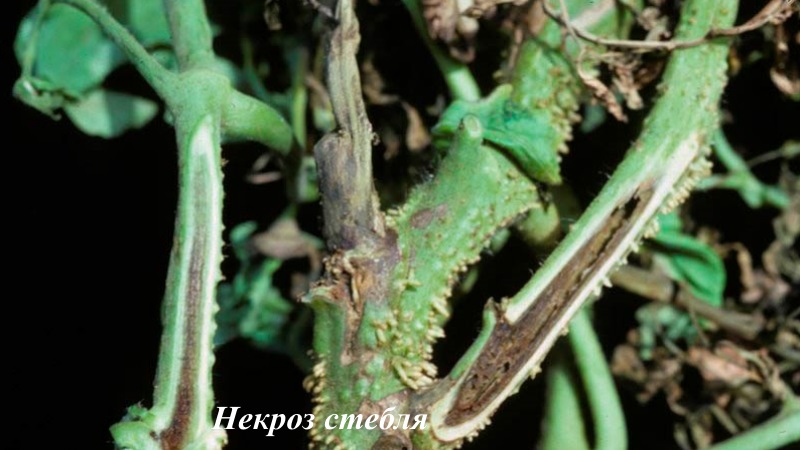
Preventive treatment of tomato seeds
On the surface of the seeds and under the seed coat, causative agents of fungal diseases, pathogenic microorganisms (bacteria, viruses) can remain. Therefore, the seeds must be pickled before planting, especially if you yourself have prepared them.
If the seed is from well-known manufacturers, then pre-sowing treatment can be skipped, since they have already been disinfected and treated with growth preparations.
For bacterial diseases, many gardeners treat seeds with aloe juice. For this, the plucked aloe leaves are kept for 6-7 days in the dark at a temperature of plus 2 ° C, then the juice is squeezed out and diluted with water in equal shares. In the resulting solution, the seeds are kept for 18-24 hours.
Perfectly disinfects seeds infusion of garlic in water (two crushed cloves of garlic per 100 g of water). The seeds are kept for 1 hour in a freshly prepared infusion of garlic, then dried.
Brilliant green seeds disinfect well at a concentration of 1 teaspoon per 100 ml of water and a 0.05% solution of chlorhexidine bigluconate diluted with water in a 1: 1 ratio. Seeds kept in solution for 30 minutes, then washed, germinated in wet wipes or dried and planted in prepared soil.
Seedling care
Before planting seedlings, the soil needs to be processed - spilled with solutions of "Fitosporin", "Sporobacterin", "Flora-S", "Fitop-Flora-S", "Glyokladina", "Trichocin", etc. Then you should thoroughly loosen the soil.
Before planting in the ground, for 1-2 days, tomatoes are treated with drugs that strengthen immunity ("Zircon", "HB-101", "Athlete", "Fitosporin", etc.). Then, 12 days after transplanting, the plants are sprayed again. The soil under the tomatoes is mulched with straw, agrofibre, or sown with New Zealand spinach.
Seedling treatments are carried out every week or 2 weeks, depending on weather conditions.

Varieties resistant to late blight infection
There are no varieties that are absolutely resistant to late blight! There are varieties that are more successful in resisting the disease.Most often these are hybrid varieties. For a good harvest, it is worth planting early ripe tomatoes, the harvest of which is harvested before mass destruction by late blight.
Resistant varieties before late blight include: Blizzard, Budenovka, Kostroma, Pink dwarf, Parterre, Profitable, Otradny, Dubrava, Lark F1, De Barao, Berry, Sunny, Grotto, Snezhana, Cameo, Vilina, Liana, Roton, Cardinal, Carlson, Tatyana, Darling of fate, Anyuta, Snowstorm, Raisa, Babushkin's secret, etc.
Preventive measures will be required in any case, especially in adverse weather conditions.
Frequently asked Questions
Often, due to unfavorable weather, late blight still wins and affects plants. Then, to save the harvest, the tomatoes are harvested before ripening.
How to save plucked tomatoes?
Tomatoes can even be picked from sick bushes. When late blight is affected, the bush does not turn black immediately and the disease does not affect the fruits from the inside. The disease affects the outside of the fruit. Therefore, picking tomatoes from already diseased bushes is possible and even necessary so as not to lose the harvest.
After harvesting, wash the fruits thoroughly with warm running water and spread them to ripen in a warm place.
Can I water late blight-infected tomatoes?
During illness, watering the bushes is not worth it, so as not to increase the humidity.
Can I use for food, canned tomatoes affected by late blight?
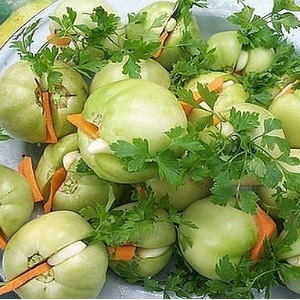 It is unpleasant to eat blackened tomatoes, but it is possible, since late blight is not transmitted to humans. Of course, if the tomatoes are still green, then they cannot be eaten, because they contain solanine, a toxic alkaloid. However, in the process of salting or heat treatment, the solanine is destroyed, and the tomatoes acquire the taste of all the spices and seasonings with which they are pickled.
It is unpleasant to eat blackened tomatoes, but it is possible, since late blight is not transmitted to humans. Of course, if the tomatoes are still green, then they cannot be eaten, because they contain solanine, a toxic alkaloid. However, in the process of salting or heat treatment, the solanine is destroyed, and the tomatoes acquire the taste of all the spices and seasonings with which they are pickled.
For example, here is an interesting recipe for pickled green tomatoes with garlic - "Garlic Bouquet". To prepare a snack, you need 5 kg of tomatoes, several heads of garlic, 3-4 medium carrots, 100 g of dill, 6 bay leaves, 2 cups of 9% table vinegar, 125 g of granulated sugar and 250 g of table salt.
Each tomato is cut, garlic cloves and carrot pieces are inserted into the cuts. Prepared tomatoes, along with bay leaves and dill inflorescences, are placed in a jar and poured with boiling marinade, rolled up and left under a blanket to cool. It is better to store such a workpiece in a room where the temperature does not exceed + 18 ° C.
How to cultivate the land after a disease?
Surface spraying of plants will not give the desired effect, since most pathogens live in the soil.
Therefore, tillage is mandatory. For this purpose, use "Fitosporin-M" or "Arilin-B" in combination with "Trichocin" or "Glyocladin". If there are no such funds, spill the soil with hot water with potassium permanganate and close the greenhouse.
Siderates will also help to destroy the pathogenic microflora. In autumn and spring, the soil where the tomatoes grew is sown with white mustard, which has the property of disinfecting the soil with phytoncides.
Conclusion
As you can see, there are many methods of protection against diseases, but how and how to process tomatoes in your garden is up to you. Complete cure of the disease does not guarantee any of the listed methods. To effectively combat the onset of tomato disease, it is better to alternate different methods.
Video on methods of combating fungal diseases of tomatoes: